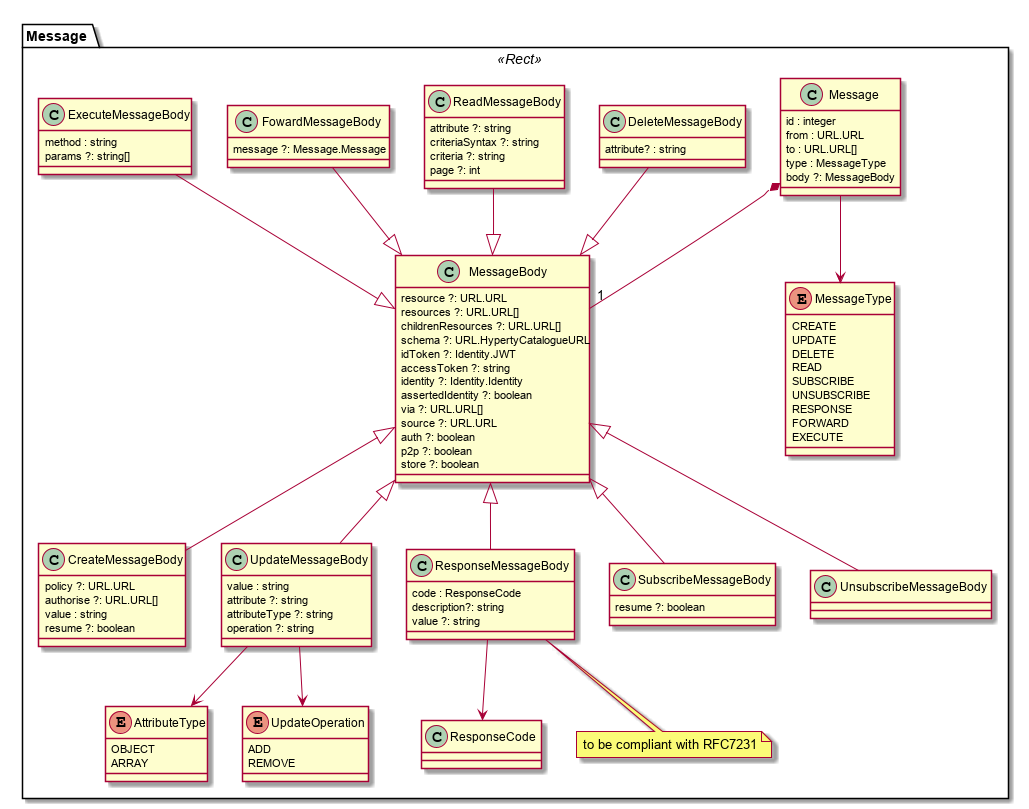Message
Message Model

Header
Fields needed to route messages.
id
To be used to associate Response messages to the initial request message.
type
Message type that will be used to define the Message Body format.
from
URL of Hyperty instance or User associated with it
to
One or more URLs of Message recipients. According to the URL scheme it may be handled in different ways
Message Body
Optionally, message bodies can contain JWT tokens for Access Control or for Identity Assertion purposes. See here for more details.
The “MessageBody.via” attribute contains a list of all Protostub addresses (Protostub) that the message has been passed through. It is used to prevent infinite cycles in the Hyperty Messaging Framework.
The MessageBody.source contains the original creator of the message. Useful e.g. to identify the real source of the response to a one-to-many message delivery ie multiple responses coming from different sources.
The MessageBody.auth is used by the policy engine to set the Message was authorised (true) or that no policy was found by the Policy Engine to be enforced in this message (false).
The MessageBody.p2p is used by the Runtime Registry to decide if a P2P Connection Stub should be deployed (true) or not (false).
The MessageBody.store is used to decide if data associated with the message should be stored (true) or not (false).
CreateMessageBody
value
Contains the created object in JSON format.
policy
URL from where access policy control can be downloaded. Examples:
-
reporter-observer where only reporter can make changes
-
similar to previous one but observers can request reporters to make changes
Policy to be enforced by Monitor component colocated with Connector sandbox?
resume
Used for data sync resume procedures for data object reporters.
ResponseMessageBody
Code
A response code compliant with HTTP response codes (RFC7231).
Description
Description of response code compliant with HTTP response codes (RFC7231).
Value
Contains a data value in JSON format. Applicable to Responses to READ MessageType.
ReadMessageBody
attribute
Identifies the attribute in the Object to be read (optional)
criteriaSyntax
Defines the criteria syntax used in criteria field. To be used for search purposes. Valid criteria Syntaxes are: “key-value”, “mongodb”, “sql”(?), …
criteria
Defines the criteria to be used for search purposes. Syntax used to define the criteria is set in the criteriaSyntax.
page
To be used for large Resources to identify the number of the page to be read from the resource. Example, for arrays or JSON objects, if each page contains 50 elements, a request for page number 2 should return [50 - 99] elements or objects range.
UpdateMessageBody
attribute (optional)
Identifies the attribute in the Object that is updated
value
Contains the updated value object in JSON format.
attributeType (optional)
To indicate whether it is an array that is updated.
operation (optional)
Operation to be performed in an array: add or remove
DeleteMessageBody
attribute
Identifies the attribute in the Object that is deleted (optional)
FowardMessageBody
message
Contains forwarded message.
ExecuteMessageBody
Contains the name of method to be invoked and an array and an Array of objects to be passed as parameters to the defined method. This is compliant with JSON-RPC Spec.
SubscribeMessageBody
resume
Used for data sync resume procedures for data object observers.
UnsubscribeMessageBody
Optional attribute unsubscribe is a list of URLs to be unsubscribed from.
Procedures
Request - Response transactions
A Response to a Request message should follow this rule:
- Response.from = Request.to
- Response.to = Request.from
- Response.id = Request.id
It should be note, the Request.id MUST be incremented every time a new Request message is created.